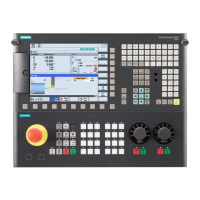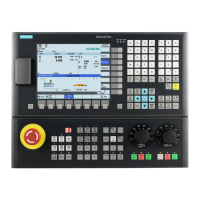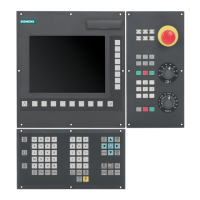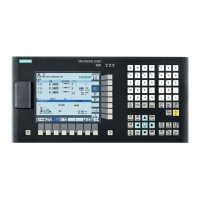P5: Oscillation - only 840D sl
11.2 Asynchronous oscillation
Extended Functions
642 Function Manual, 03/2013, 6FC5397-1BP40-3BA1
Control methods
Oscillation movements can be controlled by various methods:
● The oscillation movement and/or infeed can be interrupted by delete distance-to-go.
● The reversal points can be altered via NC program, PLC, HMI, handwheel or directional
keys.
● The feedrate velocity of the oscillation axis can be altered through a value input in the NC
program, PLC, HMI or via an override. The feedrate can be programmed to be dependent
on a master spindle, rotary axis or spindle (revolutional feedrate).
References:
Function Manual, Basic Functions; Feedrates (V1)
● The oscillation movement can be controlled entirely by the PLC.
Methods of oscillation control
There are two modes of oscillation:
1. Asynchronous oscillation:
Is active across block boundaries and can also be started from the PLC/HMI.
2. Oscillation by synchronized movement actions:
In this case the asynchronous oscillation and an infeed movement are coupled via
synchronized actions. In this way, it is possible to program oscillation with infeed at the
reversal points which is active on a non-modal basis.
11.2 Asynchronous oscillation
Characteristics
The characteristics of asynchronous oscillation are as follows:
● The oscillation axis oscillates backwards and forwards between reversal points at the
specified feedrate until the oscillation movement is deactivated or until there is an
appropriate response to a supplementary condition. If the oscillation axis is not positioned
at reversal point 1 when the movement is started, then it traverses to this point first.
● Linear interpolation G01 is active for the oscillation axis regardless of the G code
currently valid in the program. Alternately, revolutional feedrate G95 can be activated.
● Asynchronous oscillation is active on an axis-specific basis beyond block limits.
● Several oscillation axes (i.e. maximum number of positioning axes) can be active at the
same time.

